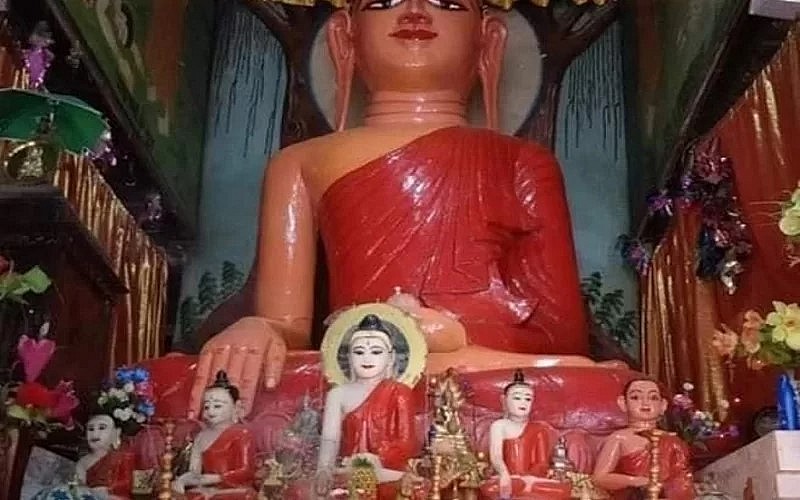Rediscovering the Buddhist Legacy: Unainpūrā Laṅkārāma and the Indian Connection
 |
Boṅgabhūmi reached the zenith of its Buddhist glory during the reign of renowned rulers such as Aśoka of the Maurya Dynasty, the Gupta Dynasty, and the Pāla Dynasty. Over the centuries, the construction of numerous Buddhist monasteries contributed to the dissemination of Buddhist wisdom throughout this vast territory.
However, as the sands of time shifted, the Buddhist presence in modern-day Bangladesh began to wane after the 12th century. Only a handful of resilient monasteries continued to uphold the traditions and teachings of Buddhism, facing immense challenges and adversity. One such beacon of hope is Unainpūrā Laṅkārāma, nestled in the village of Unainpūra, within the sub-district of Patiya and the district of Chattogram, also known as Chittagong.
Unainpūra is a spiritual village that boasts a unique connection to Buddhism. It is the birthplace of numerous Buddhist scholars, monks, and spiritual leaders who, over the course of centuries, played a pivotal role in the spread of Theravāda Buddhism not only in Boṅgabhūmi but also in the broader Indian subcontinent.
According to local historical records and a white stone rock edict that traces the monastery’s history back to the 1600s, Unainpūrā Laṅkārāma holds the distinction of being the birthplace of 16 prominent monks who have left an indelible mark on the course of Buddhism. These monks, listed in chronological order, exemplify the deep-rooted connection between Unainpūra and the Buddhist tradition.
Two figures from more recent times, Ācārya Pūrṇāchār Chandramōhan Mahāsthabir (1834–1907) and his disciple, Kṛpāśaraṇa Mahāsthabir (1865–1926), stand out as influential figures in the doctrinal and institutional reconstruction of Theravāda Buddhism in contemporary Boṅgabhūmi.
Ācārya Pūrṇāchār Chandramōhan Mahāsthabir, also known as the 2nd Supreme Patriarch (saṅgharāj) of Bangladesh, remains a revered figure in the hearts of devotees, seekers, and monastics across the globe. His tireless efforts included an initiative to reform Theravāda Buddhism, ensuring its continued relevance in the modern era.
Unainpūrā Laṅkārāma is not just a historical relic, but a living testament to the enduring spirit of Theravāda Buddhism. From its esteemed leader Joydharā Mahāsthabir to the venerable Ven. Ratana Nanda Bhikkhu, the monastic community of Unainpūrā Laṅkārāma continues to uphold and impart the teachings of the Buddha. Their unwavering dedication is mirrored by the villagers of Unainpūra, who have, for generations, provided continuous support in the form of the four requisites – food, clothing, shelter, and medicine – to the monks of Unainpūrā Laṅkārāma.
In recognition of its significant contributions to the preservation of Bangladeshi Buddhist practice, manuscripts, and heritage, Unainpūrā Laṅkārāma stands as a pioneer institution of Theravāda Buddhism in Boṅgabhūmi. It continues to be a stalwart guardian of the rich Buddhist legacy, both in the region and in India, where the echoes of Siddhartha Gautama’s teachings still resound.
As we retrace the footsteps of the Buddha and the luminaries who followed in his path, Unainpūrā Laṅkārāma reminds us of the enduring importance of this ancient tradition in a rapidly changing world, reinforcing the deep and unbreakable connection between India and Buddhism.
Recommended
 World
World
Pakistan NCRC report explores emerging child rights issues
 World
World
"India has right to defend herself against terror," says German Foreign Minister, endorses Op Sindoor
 World
World
‘We stand with India’: Japan, UAE back New Delhi over its global outreach against terror
 World
World
'Action Was Entirely Justifiable': Former US NSA John Bolton Backs India's Right After Pahalgam Attack
 World
World
US, China Conclude Trade Talks with Positive Outcome
 World
World
Nifty, Sensex jumped more than 2% in opening as India-Pakistan tensions ease
 World
World
Easing of US-China Tariffs: Markets React Positively, Experts Remain Cautious
 World
World
